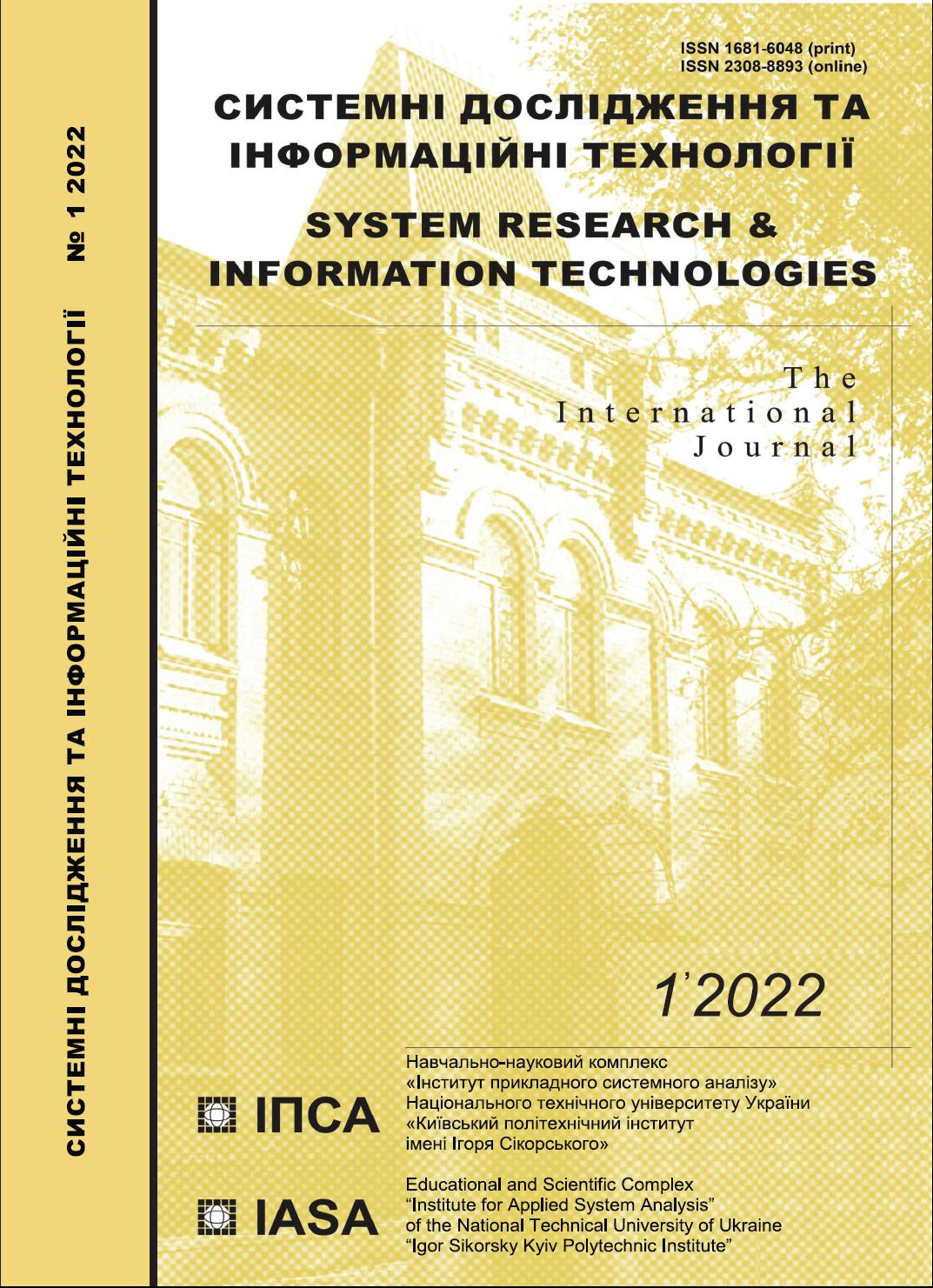System analysis of the problem of establishing the authenticity and authority of painting works
DOI:
https://doi.org/10.20535/SRIT.2308-8893.2022.1.04Keywords:
intelligent decision-making system, automatic classification, k-nearest neighbors, customs examination, paintingsAbstract
Cultural values have long been the objects of crimes, among which the export from the state stands out. Falsification hides artworks from customs control and its detection requires a long examination using a variety of methods of analysis. This article discusses the task of verifying painting’s authenticity during customs inspection. A two-stage procedure is proposed, which includes a quick check based on the analysis of painting’s images and a longer museum expertize. To implement the image analysis, it is proposed to use an intelligent decision-making system, which is based on a classifier that implements the k-nearest neighbors algorithm. A set of features to describe painting’s properties is formed, metrics for calculating the similarity measure on objects in the course of classification is proposed. To train an algorithm, a dataset is proposed, which includes paintings by world and European artists, as well as Ukrainian painters from different centuries.
References
A. Mironova, F. Robache, R. Deltombe, R. Guibert, L. Nys, and M. Bigerelle, “Digital Cultural Heritage Preservation in Art Painting: A Surface Roughness Approach to the Brush Strokes”, Sensors, 20, 6269, 2020. doi:10.3390/s20216269.
K. Zreik and N. Bouhai, “Post-digital design: The Hyperheritage project”, in Proceedings of the SHoCK—Sharing of Computable Knowledge; A. Fioravanti, S. Cursi, S. Elahmar, S. Gargaro (Eds.); eCAADe 35: Rome, Italy, 2017, pp. 49–54.
W.S. Elkhuizen et al., “Comparison of three 3D scanning techniques for paintings, as applied to Vermeer’s ‘Girl with a Pearl Earring’”, Herit. Sci., 7, 89, 2019.
M.J.W. Van Hengstum et al., “Development of a high resolution topography and color scanner to capture crack patterns of paintings”, Proceedings of the EUROGRAPHICS Workshop on Graphics and Cultural Heritage, Vienna, Austria, 12–15 November 2018, pp. 11–20.
C.-C. Carbon and V.M. Hesslinger, “On the nature of the background behind Mona Lisa”, Leonardo, 48, pp. 183–184, 2015.
G.J.A.M. Eumelen, E. Bosco, A.S.J. Suiker, A. van Loon, and P.D. Iedema, “A computational model for chemo-mechanical degradation of historical oil paintings due to metal soap formation”, J. Mech. Phys. Solids, 132, 103683, 2019.
L. Shamir, T. Macura, N. Orlov, M.D. Eckley, and I.G. Goldberg, “Impressionism, Expressionism, Surrealism: Automated Recognition of Painters and Schools of Art”, ACM Transactions on Applied Perception, vol. 7 (2), pp. 1–18, 2010.
F.S. Khan, S. Beigpou, J. Van de Weijer, and M. Felsberg, “Painting-91: a large scale database for computational painting categorization”, Machine Vision and Applications, 25(6), pp. 1385–1397, 2014. Available: https://doi.org/10.1007/s00138-014-0621-6 9. D. Wang and Y. Chen, “Calculation and Application of Xin’an Painting School Art Style Model”, ICAITA, 1651, 012033, 2020. doi: 10.1088/1742-6596/1651/1/012033.
L. Liu, J. Chen, P. Fieguth, G. Zhao, R. Chellappa, and M. Pietikäinen, “From BoW to CNN: Two decades of texture representation for texture classification”, Int. J. Comput. Vis., 127, pp. 74–109, 2019.
B. Saleh and A. Elgammal, “Large-scale Classification of Fine-Art Paintings: Learning The Right Metric on The Right Feature”, Digital Art History, no. 2, 2016. Available: https://doi.org/10.11588/dah.2016.2.23376
V. Balntas, K. Lenc, A. Vedaldi, and K. Mikolajczyk, “HPatches: A benchmark and evaluation of handcrafted and learned local descriptors”, IEEE Conference on Computer Vision and Pattern Recognition (CVPR), 2017.
X. Zang, F.X. Yu, S. Karaman, and Sh.-F. Chang, “Learning discriminative and transformation covariant local feature detectors”, IEEE Conference on Computer Vision and Pattern Recognition (CVPR), 2017.
K. He, Y. Lu, and S. Sclaroff, “Local descriptors optimized for average precision”, IEEE Conference on Computer Vision and Pattern Recognition (CVPR), 2018.
R. Srinivasan and K. Uchino, Quantifying Confounding Bias in Generative Art: A Case Study. Available: arXiv: 2102.11957v1 [cs.CY] 23 Feb 2021.
A. Elgamma, B. Liu, M. Elhosein, and M. Mazzone, “Can: Creative adversarial networks, generating ”art” by learning about styles and deviating from style norms”, International Conference on Computational Creativity (ICCC), 2017.
M. Sung, The ai renaissance portrait generator isn’t great at painting people of color. 2019. Available: https://mashable.com/article/ai-portrait-generator-pocs/
W.R. Tan, Ch.S. Chan, and K. Tanaka, “ArtGAN: Artwork synthesis with conditional categorical GANs”, 2017 IEEE International Conference on Image Processing (ICIP), 2017, pp. 3760–3764. doi: 10.1109/ICIP.2017.8296985.
A. Martynenko, V. Moroz, and I. Nulina, “An intelligent decision support system for cultural property identification”, Computer-IntegratedTechnologies: Education, Science, Production, 39, pp. 78–82, 2020. Available: http://cit-journal.com.ua/ index.php/cit/article/view/126
D.G. Lowe, “Object recognition from local scale-invariant features”, Proceedings of the International Conference on Computer Vision, 2, pp. 1150–1157, 1999. doi: 10.1109/ICCV.1999.790410
M.D. Fairchild, Color Appearance Models. John Wiley and Sons, 2005, 340 p.
Z. Guo, L. Zhang, and D. Zhang, “A completed modeling of local binary pattern operator for texture classification”, IEEE Trans. on Image Processing, vol. 19, issue 6, pp. 1657–1663, 2010.
WikiArt. Visual art encyclopedia. Available: https://www.wikiart.org/en/
Arkyves. Available: http://arkyves.org/
Art UK. Available: https://artuk.org/
Artsy. Available: https://www.artsy.net/
Behance. Available: https://www.behance.net/
Artnet. Available: https://www.artnet.com/
Kaggle. Available: https://www.kaggle.com/ikarus777/best-artworks-of-all-time/tasks
Hermiage. Available: http://collections.hermitage.ru/entity/COLLECTION
National Art Museum of Ukraine. Available: http://namu.kiev.ua/ua/gallery/whole-gallery.html

